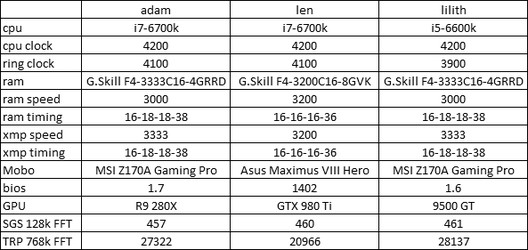- Joined
- Mar 7, 2008
As background, last August I built an i7-6700k based system, and apart from some more or less solved ram stability, all was great. It was particularly fast at PrimeGrid where I spend a lot of CPU cycles. For practical purposes, you can compare it to running Prime95 24/7 as most of the heavy lifting is based on the same underlying code library.
I liked it so much, I wanted another one. I didn't want to spend as much on this system, as it would be a pure cruncher, so I went for the i5-6600k instead. Performance was disappointing. It was tens of % slower than the i7 system, putting it roughly comparable to Haswell i5 territory in IPC. Now, this isn't a fair comparison, since they weren't exactly the same configuration, but still the difference was more than I expected. As summary, I was running both CPUs at 4.2 GHz (4 cores active), i7 had faster ram 3200 vs 3000, and the i7 ring was a little faster too but I forget the exact numbers.
Earlier this week, I thought I'd get another i7 system to play with. I didn't really want to tinker with the old i7 since it is my daily use machine. I picked the same mobo as the i5 (MSI Gaming Pro), same cooler, same ram (other half of quad kit G.Skill Ripjaws 4 3333 but I never got it 100% stable and went down to 3000). Both have GPUs so as to avoid loading from the built in GPU.
Now, this new i7 I've had for less than 24 hours. I only had time to assemble it and clone the OS from the i5 system just to get it running quickly. I still need to tinker with it a lot more but HWInfo appears to be suggesting current limiting might be activating. I only just saw Intel XTU can also report that in real time so I will be trying that later. For now, the CPU is at stock, and I've copied the same 3000 ram settings from the i5 system (same mobo, same ram, so hopefully will be ok). I will add the i7 has the latest bios with Skylake bug fix, but I haven't applied this to the i5 system yet.
So quick questions for now:
1, has anyone experienced current limiting with i7-6700k? I'm still researching this and I need to try relaxing the limits in the mobo, although total power use suggests I shouldn't be hitting this anyway.
2, has anyone observed massive performance differences (>10%) between similarly clocked i5-6600k and i7-6700k? I expected things to be ram bandwidth limited since the workloads are too big to fit within the cache, but we do have a difference in cache size and associativity between them which may be a bigger factor.
I liked it so much, I wanted another one. I didn't want to spend as much on this system, as it would be a pure cruncher, so I went for the i5-6600k instead. Performance was disappointing. It was tens of % slower than the i7 system, putting it roughly comparable to Haswell i5 territory in IPC. Now, this isn't a fair comparison, since they weren't exactly the same configuration, but still the difference was more than I expected. As summary, I was running both CPUs at 4.2 GHz (4 cores active), i7 had faster ram 3200 vs 3000, and the i7 ring was a little faster too but I forget the exact numbers.
Earlier this week, I thought I'd get another i7 system to play with. I didn't really want to tinker with the old i7 since it is my daily use machine. I picked the same mobo as the i5 (MSI Gaming Pro), same cooler, same ram (other half of quad kit G.Skill Ripjaws 4 3333 but I never got it 100% stable and went down to 3000). Both have GPUs so as to avoid loading from the built in GPU.
Now, this new i7 I've had for less than 24 hours. I only had time to assemble it and clone the OS from the i5 system just to get it running quickly. I still need to tinker with it a lot more but HWInfo appears to be suggesting current limiting might be activating. I only just saw Intel XTU can also report that in real time so I will be trying that later. For now, the CPU is at stock, and I've copied the same 3000 ram settings from the i5 system (same mobo, same ram, so hopefully will be ok). I will add the i7 has the latest bios with Skylake bug fix, but I haven't applied this to the i5 system yet.
So quick questions for now:
1, has anyone experienced current limiting with i7-6700k? I'm still researching this and I need to try relaxing the limits in the mobo, although total power use suggests I shouldn't be hitting this anyway.
2, has anyone observed massive performance differences (>10%) between similarly clocked i5-6600k and i7-6700k? I expected things to be ram bandwidth limited since the workloads are too big to fit within the cache, but we do have a difference in cache size and associativity between them which may be a bigger factor.
